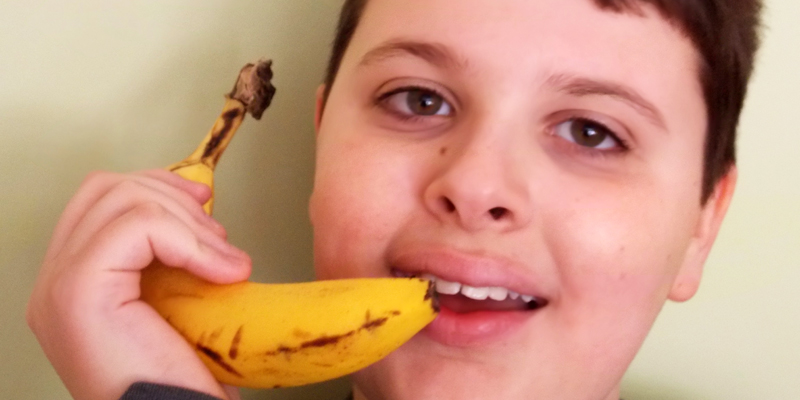
Ring, Ring, Banana Phone
The telephone rings, and both my children run to the fruit bowl to grab a banana. My son Jay gets there first, picks it up, and says, “Hello, hello. I’m sorry, you are going to have to speak up. I can’t hear you!” Then both he and his little sister Grace fall to the floor cracking up in laughter. It’s just another day of learning in the Fuentes House.
Yes, you read correctly…I did write learning! Children are remarkable and capable of learning extraordinary things, but sometimes, they may need different approaches to get there. Like say, oh, I don’t know…a banana!
(SPECIAL OFFER: Sign up for Playful Bee’s Bee Well developmental learning program to give your child the best start in life. The first 10,000 children enroll for FREE! Sign up today.)
My son Jay has Asperger’s Syndrome, an autism spectrum neurological disorder. His brain works, but at times all the information received from his senses can get misfiled or lost. When this happens he can become understandably frustrated or overwhelmed and even shut down. Not what you would call a picture-perfect setting for learning.
Chances are you already know someone like my Jay who may be wired just a little differently. According to the Centers for Disease Control and Prevention (CDC), 1 in 88 children are diagnosed on the autism spectrum. That astounding ratio changes to approximately 1 in 6 children when you include other developmental delays and diagnosis, such as ADHD, epilepsy, dyslexia and other specific learning disabilities. The point is, there are a lot of kids out there, like Jay, who are having a hard time trying to navigate the typical American-style-classroom method of education.
As a parent, we want to do whatever we can to help our children grow up healthy and smart and succeed in life. But sometimes a simple Band-Aid and a kiss on the knee is not enough. A mama has to get creative when she has a special needs child. Sometimes she has to pull out a banana and play make-believe!
We all know that play offers an abundance of benefits for all developing children. When children play, they are experimenting with roles, interacting with others, and developing cognitive thinking, abstract thinking, and communication skills. Typically, developing children practice and acquire culturally-appropriate social skills and behaviors simply by playing with or in parallel to other children. However, many special needs children tend to have a deficiency in these areas. Children with autism, like Jay, usually prefer to play alone. They also exhibit repetitive behaviors and often have a hard time participating in imaginary play.
It used to be that if you gave my son a banana and told him it was a phone he would sit there and stare at it, or perhaps just eat it! Okay, that is an appropriate response; I will give him that. But if I tried to initiate playing, to make-believe that the banana really was a phone, he would argue with me and go into great detail as to how exactly a phone and a banana were completely different. His brain is not wired to think that way, so he couldn’t see anything but a banana or a phone. But that doesn’t mean he doesn’t have an imagination. Rather, it means that he needed to be shown how to use it! Of course now, after years of playing like this, Jay gets it and, as I mentioned before, will even race his sister to be the first to answer our Banana Phone.
I talk from personal experience when I say that many children with different abilities (a term we prefer to use over disabilities) benefit from the multi-sensory approach of play-based learning. You don’t have to take my word for it—give it a try. All you need is a banana, a little bit of patience, and a good imagination!
(SPECIAL OFFER: Sign up for Playful Bee’s Bee Well developmental learning program to give your child the best start in life. The first 10,000 children enroll for FREE! Sign up today.)
For more information:
What to Expect. What’s Parallel Play? What to Expect: Pregnancy and Parenting, Every Step of the Way. Retrieved April 4, 2013 from http://www.whattoexpect.com/playroom/playtime-tips/what-is-parallel-play.aspx.
Logsdon, Ann. Make Multisensory Teaching Materials. About.com: Parenting: Learning Disabilities. Retrieved April 4, 2013 from http://learningdisabilities.about.com/od/instructionalmaterials/p/mulitsensory.htm.
Office of the Associate Director for Communication, Division of News and Electronic Media (2012). CDC Estimates 1 in 88 Children in United States Has Been Identified as Having an Autism Spectrum Disorder. Centers for Disease Control and Prevention. Retrieved April 4, 2013 from http://www.cdc.gov/media/releases/2012/p0329_autism_disorder.html.
National Center on Birth Defects and Developmental Disabilities, Division of Birth Defects (2011). Developmental Disabilities Increasing in the US. Centers for Disease Control and Prevention. Retrieved April 4, 2013 from http://www.cdc.gov/features/dsdev_disabilities/index.html.
*This post and image was contributed by guest blogger, Sharon Fuentes.
Playful Bee
Latest posts by Playful Bee (see all)
- Have a Super Fortune Cookie Friday! - February 9, 2018
- All Kinds of Shapes: Your Child Is Learning Simple Shapes, and Drawing Them Too! - November 13, 2017
- Fishing for Sneakers: Create your own Hand-Eye Coordination Fun - November 11, 2017

+ There are no comments
Add yours